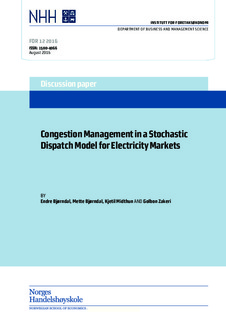Congestion Management in a Stochastic Dispatch Model for Electricity Markets
Working paper

Åpne
Permanent lenke
http://hdl.handle.net/11250/2401597Utgivelsesdato
2016-08-25Metadata
Vis full innførselSamlinger
- Discussion papers (FOR) [566]
Sammendrag
We consider an electricity market organized with two settlements: one for a pre-delivery (day-ahead) market and one for real time, where uncertainty regarding production from non-dispatchable energy sources as well as variable load is resolved in the latter stage. We formulate two models to study the efficiency of this market design. In the myopic model, the day-ahead market is cleared independently of the real-time market, while in the integrated stochastic dispatch model the possible outcomes of the real-time market clearing are considered when the day-ahead market is cleared. We focus on how changes in the design of the electricity market influence the efficiency of the dispatch, measured by expected total cost or social welfare. In particular, we examine how relaxing network flow constraints and, for the stochastic dispatch model, even the balancing constraints in the day-ahead part of the dispatch models affects the overall efficiency of the system. This allows the dispatch to be infeasible day-ahead, while these infeasibilities will be handled in the real-time market. For the stochastic dispatch model we find that relaxing the network flows and balancing constraints in the dayahead part of the market provides additional flexibility that can be valuable to the system. In our examples with high up-regulation cost we find a value of "overbooking" that lead to lower total costs. In the myopic model the results are more ambiguous, however, leaving too many constraints to be resolved in the real-time market only, can lead to infeasibilities or high regulation cost.